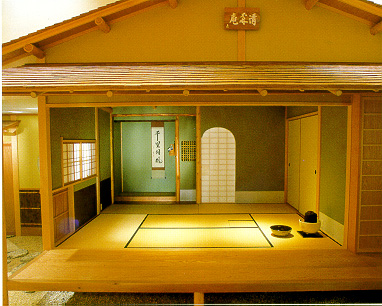Japanese Culture >> Japanese Tea House
Peek Inside a Traditional Japanese Tea House

A Japanese tea house is a special building designed for
holding Japanese tea ceremonies. It is built using simple rustic
materials and is usually surrounded by a small garden called a roji. The
garden has an important function in preparing the guests for the
Japanese tea ceremony.
Teahouses are generally small, and the floors are covered with tatami
mats. These mats are made from tightly woven rice straw and have a
covering of tightly woven rush grass that make a very smooth surface.
The layout of the tatami mats changes according to the seasons. The
Japanese do not wear shoes on tatami flooring.
All thedoors and windows in the teahouse are traditional shoji, which
are made out of thin strips of balsa wood and covered in translucent
Japanese paper, which allows light to pass through into the room.
The entrance to the teahouse is very low so that people must stoop in
order to go through – this is a symbolic gesture of humility. The
teahouse generally has two rooms inside, the mizuya, for preparing the
food, snacks and tea and for washing the utensils, and the chashitsu,
for the performance of the tea ceremony.
When the guests arrive, they are led into a waiting room, machiai, by
the host's assistant, the hanto. Then they are offered sayu (hot water
which is used for making tea). While they are here, the guests select
one person to act as the main guest. The hanto then leads the guests
into the roji. It is here that the guests “remove the dust of the
world”. Then the guests sit on a waiting bench, koshikake machiai, and
wait here until their host appears to greet them.
Inside the teahouse there are no decorations except for a scroll
painting, kakemono, which is hung in alcove called a tokonoma. This is
carefully chosen by the host to make known the theme of the tea
ceremony.
Tea houses are often given a name by their owners. These names reflect
the simplicity of the tea ceremony and the teachings of Zen Buddhism.
About the Author:
Mayoor Patel is the writer for the website
http://tea-party.tea-universe.com/. Please visit for information on all
things concerned with
Tea House.
